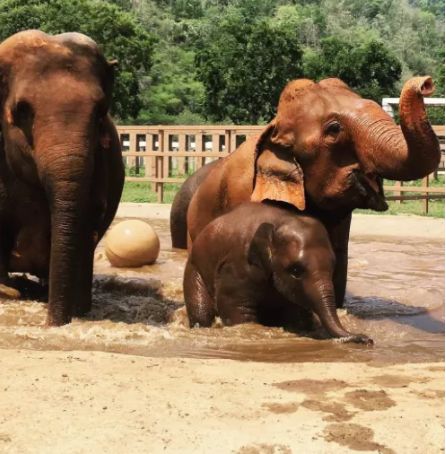
I’m standing in a muddy field next to a river when the rain hits. It comes out of nowhere and it comes down hard. The corn and straw we’re raking is immediately soggy and impossible to move into a pile. We try anyway, then give up. The rain gets harder. Carrying a collection of rusty shovels and rakes about 10 other volunteers and I run for shelter under a tree. The rain isn’t necessarily unwelcome–it’s 92 degrees with 70-percent humidity in Chiang Mai today, but it isn’t exactly pleasant either. The mud gets slick and sunscreen flows into my eyes. Then, I look up and see an elephant playing with tires hanging from a rope, and another waving her trunk in the air in the distance. There are worse places to be stuck in the rain.
I’m at Elephant Nature Park for a week of volunteering. The park is a sanctuary and rescue center for elephants, as well as some dogs, cats, and buffalo. During our trip, there were 70 elephants at the park. These elephants have been rescued from things like logging, trekking, street begging, entertainment, and other abuse. You know those parks where you can ride elephants? Bad idea. Circuses? Even worse. Let’s not even talk about poaching for ivory, it’s too depressing, as was the video we watched on the first day of volunteering. In it, we saw the cruelty elephants go through during training for any number of roles, from lugging logs to serving as entertainment for children, or so tourists in Thailand can say they’ve taken a ride on an elephant. The process of taming elephants in Southeast Asia is called phajaan, meaning the crush. That should tell you something. Baby elephants are taken from their mothers, kept in a small space, beaten into submission, sometimes pierced with hooks, and deprived of sleep and food until they’re broken. Here’s a very disturbing video showing some of the process.
So, don’t ride elephants in Thailand. I repeat, do not ride elephants in Thailand. It’s probably not a good idea in the rest of the world either, though zoos in the United States do have some protections and train elephants in different, more humane ways. (I don’t know enough about this to say if it’s completely humane though, so do your research before participating in any elephant related tourism). Asian elephants are endangered, and Elephant Nature Park aims to help individual elephants who have gone through trauma, as well as the species at a whole. So far, three babies have been born at the park, and these elephants will never have to suffer any sort of cruelty.

At the park, you can watch elephants all day long, feed them sometimes, get close to them, maybe touch them but only if there’s a mahout (a professional companion to the elephant) around who says it’s ok, and splash around with them in the river. You cannot ride them, or touch them on your own whenever you want, or do anything that would startle them. The 250 acre park gives tourists an opportunity to see elephants in as close to their natural habitat as possible, while preserving the elephants’ space and comfort.
Getting There
Fly or take a train or bus to Chiang Mai, depending on where you’re coming from, then take the free shuttle from the park’s office downtown. The hour-long drive to the park is lush and wild, winding higher and higher into the jungle mountains. It’s a really beautiful, green part of the country. You’ll pass elephant parks along the way offering elephant rides. It was disturbing that they existed so close to the sanctuary, but these parks are also where many of the elephants were rescued from.
The Accommodations
A week of volunteering costs $345 and includes all meals, accommodation, and transport to and from downtown Chiang Mai. Accommodations are basic. You’ll have a bed with a mosquito net, a bathroom (some rooms have bathrooms inside, some are shared), and a shower. If you’ve traveled around Southeast Asia you’re probably used to this type of shower, which is basically a shower head in a tiled room. The water was cold, which was actually refreshing in our case, as we went in April and it was very, very hot and humid. March through June is the hot season in Thailand, and April and May are the hottest months. If you don’t do well in hot weather, don’t visit in these months. The rooms have fans and I found them warm and a bit stuffy, but not unbearable (I’m always cold), but the lack of air conditioning was an issue for others. Visit in the fall or winter if you don’t like the heat.
The Food
The food is incredible! Seriously. There’s a large buffet for breakfast, lunch, and dinner of vegetarian and vegan options. Most dishes are Thai, though there were some pastas and french fries. Everything is made fresh each day and is delicious. I was so impressed by the array of dishes each meal, and that there was always something new so we never got bored of the food. For $345 you really do get your money’s worth even if you were judging on food alone.
The Work
This is a volunteer trip, so you don’t just get to eat amazing Thai food and stare at baby elephants all day. The work isn’t too bad, but is a bit more strenuous than the website might make you believe. Some days you’ll unload watermelons from a truck and wash them (easy), others you’ll shovel elephant poop (moderately easy but gross), and others you’ll cut corn (harder).
Each volunteer task lasts about three hours, and then is countered by a more fun activity on the same day, like taking an elephant nature walk where you learn about each elephant and when/why they were rescued, or watching the elephants play in the river. You can also volunteer to play with the dogs and cats.

The highlight for many people is bathing the elephants in the river. On this day, you’ll wade into the river with a few elephants and splash buckets of water over them. It’s so cute to see them splash water over their backs with their trunks!
All levels can do all of the jobs, but some might be harder for some people. Again, in April it is very hot to be standing in the sun and shoveling/chopping/raking, so if you don’t like heat go in another season.
What to Wear at Elephant Nature Park
First of all, let me warn you that anything you wear here will smell terrible when you leave. I don’t even know what the smell is, but it was awful, and all of our clothes smelled like it. A mix of sweat, elephant stench, dirt, and who knows what else… The point is, don’t bring your best clothes. Bring workout clothes and a few lighter, linen things, especially if you go in the hot season. I wore these shorts and workout tank tops (and a sports bra, which I was so happy to be wearing instead of a regular bra) while working, and combinations of these shorts, these pants, these tank tops, and these t-shirts during non-work hours. I wore these sandals the whole time and was fine, but others wore tennis shoes. My friend Sarah brought this cooling towel, which gets cold when you wet it and then snap it. I think it saved her in the heat. You’ll get a water bottle and t-shirt on arrival, which are really useful too!
My Takeaway
Elephant Nature Park is a fantastic organization. It is the only place I would recommend anyone see elephants in the country, as it is the only one that puts the elephants above tourism. The park is beautiful and it’s really cool to see the elephants wandering around. The volunteer activities are fun for the most part, and you’ll probably meet some really cool people. I do think the volunteer activities would get repetitive after a few days and the thrill of seeing elephants while eating breakfast might wear off. We left after three full days because we had limited time to spend in Thailand, and in the end I thought we had the perfect amount of time there. You can do shorter volunteer programs or day trips, or you can pay for the full week like we did and then leave early. I didn’t mind doing this, as the money still went to a good cause and it didn’t feel like they actually needed us there for labor.

Overall, visiting Elephant Nature Park, either for a day or a week, is a great addition to your Thailand trip! The staff are wonderful and the elephants really are so adorable and majestic. I highly recommend going at least for a day if you can, even if only to learn about elephant training and the park’s mission.
Have any questions about visiting Elephant Nature Park? Get in touch!
Want to know how you can start a travel blog? Click here. Want to know how you can travel the world for a living? I can help!
